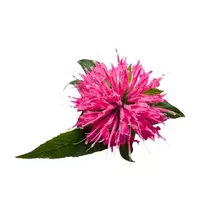Bee balm

Thanks to its decorativeness and wonderful aroma, monardou is most often grown in flower beds and spicy kindergartens. Since this plant does not require special trouble and blooms from July to the very end of autumn, Monard is loved by many gardeners.
Meanwhile, North America is considered the birthplace of this aromatic plant, and the monard appeared on European territory only in the 16th century thanks to Nicholas Monardes, a Spanish botanist. Most likely, this is where its modern name comes from.
Sometimes this plant is mistakenly mistaken for bergamia (citrus plant), which is often flavored with the famous Earl Gray tea - and in fact, the aroma of monarda leaves is very similar to the smell of bergamot. In addition, sometimes monardou is also called bee balm or American balm.
Usually this plant reaches a height of no more than one and a half meters, while it is characterized by the presence of a long, horizontally located rhizome, erect leafy stems that are tetrahedral and covered with thin hairs.
The light green leaves of the monard are distinguished by reddish veins, which are opposite. The shape of the leaf can be described as oval, coarse-toothed and pointed at the end.
The very beautiful monard capitate inflorescence is formed by thirty tubular-funnel-shaped flowers, which are brightly purple, red or purple in color. At the end of flowering, a dry fruit is formed, which cracks into 4 nuts.
As a spice, monardou is often used in the industrial production of vermouth. In addition, for culinary purposes, this aromatic plant is used in England and the USA, where monardou is consumed as a seasoning for meat, as well as as an excellent tea flavor.
Monarda species
Among a considerable number of diverse species, monards have the most widespread 2 main ones - tubular monard and double monard. It is in the latter that a strong antiseptic is isolated - timol. And due to the mass of useful properties of the monard, it is widely used for medicinal purposes.
Monarda composition
In the composition of the twin monard, such useful natural substances as essential oils (based on a dry weight of about
2. 4 percent), vitamins (C, V2 and B
1), as well as other biologically active elements and compounds were found.
Monarda benefits
The benefits of monarda are especially relevant in homeopathy, where this plant is used fresh. For example, monard extracts are characterized by the presence of a pronounced antimicrobial effect and the ability to improve digestion.
Antihelminth, bactericidal, antibiotic activity, immunomodulatory effect are characteristic of monard double essential oil. Indications for monard-based drugs are vaginitis, otitis, cystitis, sinusitis, eczema, runny nose, impetigo, pneumonia, psoriasis, tuberculosis, bronchitis, anemia, atherosclerosis and stress.
Nevertheless, despite the obvious benefits of monardas for human health, there are contraindications to its use. In particular, this is pregnancy and lactation, as well as age up to 3 years.
monards 0 kCal
Energy value of monarda (Ratio of proteins, fats, carbohydrates - ju):
Proteins: 0 g (~ 0 kCal)
Fats: 0 g (~ 0 kCal)
Carbohydrates: 0 g (~ 0 kCal)
 Español
Español Français
Français Português
Português Русский
Русский 简体中文
简体中文 繁體中文
繁體中文 日本語
日本語 한국어
한국어 العربية
العربية Türkçe
Türkçe Қазақ
Қазақ Deutsch
Deutsch Italiano
Italiano Українська
Українська
